Audi allroad returns with all-road perfection
Filed under: Weekly test drives, Autos
By John Gilbert
A couple of decades — and an SUV craze or two — ago, a good friend of my younger son asked me how wise it would be to buy a used Audi allroad, which was a very nice and svelte station wagon-type vehicle that you could actually take off the road because of some armor-plating underneath.
Now, I’ve always been a big fan of Audi’s technology, and I’ve visited the Audi home plant in Ingolstadt, Germany, a couple of times, but I issued a word of caution to my young friend, because the word behind the scenes at that time was that Audi was going to discontinue the allroad because of slow sales. So he bought something else.
Flash forward a few years, and I saw an allroad and I realized that the drivetrain and all the mechanicals were all fine in the car, and my advice was premature for a young family in St. Paul. Now it is 2017, and while Audi is at the top of its game in competing with BMW and Mercedes for fine German car sales, I paused in my favorable impression of a new Audi A4 sedan because my test car for a mid-February week was (trumpets, please) a 2017 Audi allroad.
After this review gets filed, I’m going to notify my son’s friend and apologize for my hasty suggestion years ago, and advise him that maybe he should look anew at the allroad. Incidentally, at Audi’s insistence, allroad is spelled with a lower-case “a” just as its quattro all-wheel-drive system is spelled with a lower-case “q.” In fact, it’s amusing to note that Motor Trend, Car & Driver, and other auto publications insist on spelling it with a cap Quattro, as though that distinction makes them superior in some fashion.
The new allroad is all-new, and it is a superb vehicle, with, of course, quattro, which made confronting a Northern Minnesota snowstorm and its below-zero after-effects a simple matter, both for traction, stability, and exercising those seat-heaters.
It is based on the platform of the new A4 sedan, which has grown up in recent years with its price rising with its sophistication. It is now Audi’s base compact/midsize sedan, pushing the larger A6 and A8 up a couple of price categories. Read more
Compact crossovers rule auto-show world
Filed under: Features, Autos
By John Gilbert
CHICAGO, ILL. — The available shelf-life of an auto show is brief, but for Midwesterners who can get to the fine city of Chicago before February 20, there is a chance to turn a short trip to enjoy countless fine restaurants, nightclubs and blues joints into the chance to see all the newest stuff available from the top automakers of the world.
This may not be the most scintillating season for new vehicles, because Los Angeles and Detroit have already run their car-show course before the annual Chicago Auto Show hits McCormick Place, and most new cars have been shown already. But the nation’s best exhibition hall has a lot of things consumers will find of great interest. Mainly, the current upsurge in interest in small crossover SUVs is evident everywhere.
You can range from Ford — featuring the return of the gy-normous Expedition for large family and trailer hauling, but also tipping off its mini EcoSport, just a bit downsized from the populsr compact Escape. And the tiny but roomy C-Max which is nothing if not electrifying, remains.
The Mustang has been revised again, but its various recent styling twitches and tweaks have reached the point where a variety of them might prove impossible to discern from the others. No more V6, however, as Mustang goes from stalwart V8 to EcoBoost 4s.
KIA is showing off the all-new Stinger luxury/sports sedan in all its South Korean sleek splendor, but it also has the intriguing new Niro Hybrid compact SUV.
Toyota displays TRD sporty versions of the Tundra and Tacoma pickups and Sequoia large SUV, but finds it difficult to hide the swoopy little C-HR that starts out south of the popular RAV4 in both size and price. Its upscale Lexus display features the LS large sedan, which has taken on a much sportier demeanor, and a couple of SUVs that also play to the small but high-performance concept.
The Mazda display is easy to overlook, because the stylish group of vehicles is familiar. But they deserve scrutiny. The large CX-9 has been out a while, and the Mazda6 and Mazda3 sedans look quite the same, too, as do the new small crossovers, the CX-3 and the CX-5. The CX-5 actually is all new, and if you look closely, the red one is a red that is exclusive only to the CX-5. The true newness of all the Mazdas is something called G-Vectoring — an incredible new technological concept that gives all 2017 Mazdas the ability to tip off the driver to turn and swerve in a predictable manner that means the elimination of steering correction. The cars are beautiful, but beauty is “only” skin deep, so look closer!
Nissan, on the other hand, is leading the way in using graphic design, such as solid paint schemes of white, grey, red or black, all with stark black trim, to promote a new Midnight fleet of virtually everything it makes, from the more powerful half-ton Titan XD pickup, on down to the Rogue and all the sedans, down to the Sentra. Yet the display might be stolen by the subtly downsize Rogue Sport, which is a foot shorter than the regular Rogue. The all-new Armada stands above the other Nissans in size and capability, and a new Pathfinder, which benefits from Nissan’s new engine upgrades.
General Motors is taking a similar route, coming out with a Red Line trim feature on a large group of its vehicles. It’s a familiar idea, to use paint schemes to disguise the fact that you’ve already shown most of your stable, but of course Chevrolet has the all-electric Bolt, which continues to wrack up assorted Car of the Year awards, even though it is not yet out on the streets, and may not be until mid-summer.
Fiat Chrysler Automobiles have all sorts of new toys, featuring the Alfa Romeo Giulia — finally — and the Stelvio, which is a brother in arms with a crossover SUV so flashy that Alfa is pulling back its idea of a Giulia wagon. Also, yet another variation for the Challenger, which just introduced the AWD Challenger GT and now is hitting us with the Mopar Challenger with a giant 6.4-liter Hemi, and a Durango SRT hot rod SUV. Meanwhile, its Jeep arm displays its array and gives proper reason for why the compact Compass still exists by showing off the to-be-introduced new model with refined restyling that stays just north of the Renegade.
The Germans are not to be outdone, of course, with Volkswagen’s new Atlas large SUV as well as the Golf Alltrack and the elongated Tiguan — which will join and then probably replace the blunt but roomy-enough Tiguan, an under-appreciated vehicle that might have been well-sized for this current compact crossover trend.
BMW has its latest SUVs and also the new 5-Series, while Mercedes now has so many SUVs, crossovers and sports cars — many of them with added AMG potency — that it’s hard to find room to walk among them and identify the alphabetized nameplates that only a marketing whiz can remember.
Audi has a fine spread of Q-ship SUVs of all sizes, and sedans and coupes to seduce anyone with a tidy checkbook.
Jaguar also has a dazzling display, with its slinky coupes and new high-tech sedans, as well as the F-Pace, a hot-looking vehicle that indicates the folks at Coventry catch on when it comes to building a promising SUV. Adjoining the Jaguars is the off-road cousin Land Rover display, with new and fancy top-end SUVs and also the newly redesigned Discovery, which now has its name spelled out on the upper lip leading edge of its hood, where it used to say Land Rover.”
Subaru has a new Legacy, and it advances the company farther along the lines of being less quirky and more mainstream. Which is a good thing for Subaru, as it continues to make durable and strong flat-opposed engines that I wish would get better fuel economy.
Mitsubishi is another Japanese company that always seems to be seeking an upturn, and it now is being propped up by Nissan.Its new Outlander SUV is the only new thing, offsetting the elimination of the Lancer and its much-loved Evolution.
Hyundai is about to introduce its new Ioniq, which may indeed be iconic — or iconiq — with a choice of all-electric, hybrid or plug-in hybrid. Meanwhile, Hyundai added to its complement with the new GT version of the popular Elantra, its Civic-Corolla-Mazda3 sized compact, now with about double the high-grade steel, to 53 percent. It has a fresh new style with a hatchback-wagon theme that Hyundai designers have turned into a true sporty vehicle. So sporty, in fact, that I asked Hyundai folks why, since they offer the same 1.6-turbo 4 as the Tucson crossover, they don’t add the AWD platform under the Hyundai GT. All I got were blank stares.
But arming compacts with the very feature that is allowing compact crossovers to crowd small sedans to a lesser corner in the marketplace might be the one distinct way to fight back and change the all-out crossover SUV trend to trend of compact sedans that do the work of crossovers.
Infiniti Q50 joins world’s elite sedans
Filed under: Weekly test drives, Autos
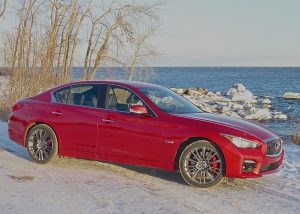
Lean and sleek styling of the new Q50 find a match in the Red Sport’s twin-turbo 3.0 V6 and AWD performance.
By John Gilbert
Even the best cars in the world are met with mixed reactions. But if no car seems capable of being all things to all customers, spend a short time with the Infiniti Q50 and you may decide it comes awfully close.
The Q50 is a sleek midsize sedan, and it can be bought in two forms, which might be considered great and greater. The top model was the one I test-drove for a week in Northern Minnesota, and it was well into winter in Duluth. Which was a good thing, for our test. The car in question was called the Q50 Red Sport 400 AWD, and it had all the goodies Infiniti could fit into that curvacious form, not the least of which was all-wheel drive.
Nissan’s potent 3.0-liter V6 is a new and high-tech powerplant that adds the extra punch of turbocharging. As in high-capacity twin turbochargers, making 400 horsepower with 350 foot-pounds of torque.
A 7-speed automatic transmission doles out all that power to the four wheels, and if you didn’t really care much for maximum fun, you could just leave it in “D” and enjoy its smooth power. Ah, but if you do enjoy driving thrills, you can shift the automatic manually with the best-designed paddle shift levers in the industry.
Companies that install paddles for fingertip shifting almost always mount them on either side of the steering wheel where they can be easily reached by thumbs, ethe right on for upshifting and left for downshifts. That works well, almost all the time.
But if you’re starting up at a T intersection, and you turn 90 degrees while accelerating, you can lose the paddle locations momentarily, usually when you shift hands, and almost always when you lost the exact location of the right paddle. Not with the Q50.
Nissan always has used long, magnesium paddles, attached to the steering column rather than the wheel. That way, if you turn the wheel hard to the left, say, and shift your hands on the wheel, as you run out of revs, you can quickly grab anywhere along the right side and you will find the paddle to upshift. Nissan uses those affixed paddles with the Infiniti Q50, meaning it begs you to shift for yourself.
When Nissan comes out with a new engine, it is always worth close scrutiny, and both engines in the Q50 are new. Without a doubt, the twin-turbo V6 boosts the Q50 to elite sports sedan prestige, comparable to, and maybe superior in some views, to BMW.
However, I am going to make a plea for anyone who is interested to first try the Q50 with the 4. It, too, is turbocharged, and even though it only has 2.0 liters of displacement, it will supply all the enthusiastic spirit you could want. The 3.0 V6 can get up to mid-30 miles per gallon in highway driving; the 2.0 turbo 4 can easily surpass and stay above 30 mpg wherever you drive.
Of course, with all-wheel drive, the Q50 AWD plowed through a 6-inch snowfall we had just up the North Shore of Lake Superior from Duluth, Minnesota, with an ease that was Jeep-like even in such foul winter weather
And here’s the less-known fact: Nissan has an arrangement with none other than Mercedes to build dual-overhead-cam, turbocharged 2.0-liter 4-cylinder engines. I spent some time with the Mercedes crossover SUVs last fall, and whether you drive the GLA, GLC, or the new GLC Coupe, as well as the C or E Class sedans, you start with a base 2.0-liter 4-cylinder turbocharged engine.
What impressed me most when I spent a week driving a Mercedes GLA was that it had plenty of punch. Its computer automatically reset itself for fuel economy each time you started up, and in a week’s time without ever getting it out for a highway road trip, I never once went anywhere up the hills of Duluth when it registered less than 32 miles per gallon.
Even more impressive, after I enjoyed the power, responsiveness and fuel-efficiency of that 4, I learned Nissan had built the engine for Mercedes. With their joint venture, some of these engines are built in various plants around the world. The 2.0 turbo 4 in the C-Class sedan is the same as the 2.0 engine built in Nissan’s Tennessee plant, while the 2.0 4 in the QX30 crossover SUV is built in Germany, then sent to the United Kingdom plant for installation.
It’s confusing, but the Infiniti engine was designed with Daimler as part of the alliance with Nissan, and while Mercedes always has had a legendary reputation with its engines, it is indeed impressive on the resume for Nissan to be building some Mercedes engines. Having the Q50, Q60, and QX30 share a 4-cylinder turbo with the C-Class, CLA, E-Class sedan and wagon, and the SLC roadster is impressive.
The 4-cylinder Q50 starts at $35,000, while the twin-turbo V6 starts at $50,700. The test car I drove had all the specialty Red Sport features. It also had hill-start assist, automatic on-off LED headlights, foglights, brake lights and turn signals. Leather trim on the seats and steering wheel set off the classy interior, which also featured Kacchu aluminum interior trim, rain-sensing wipers, power sunroof, keyless entry and push-button start, Bluetooth phone system, and Bose surround sound.
Two USB ports, cruise, voice recognition for audio, information, and Bluetooth, and the full complement of safety technology also were in place. Dynamic control, brake force distribution, traction control, tire pressure monitoring, and a vehicle immobilizer system all came standard.
The option bin produced the special Red Sport seats, matte-finish natural maple wood trim, adaptive cruise, lane-departure warning and prevention, blind spot warning, predictive collision warning, emergency braking, surround video monitor with moving object detection, backup collision intervention with rear cross-traffic alert, InTouch navigation and voice recognition, and, of course, heated front seats and steering wheel, plus remote start.
All of that lifted the price from the $50,700 Red Sport price to $62,220. That’s a long way up from the $35,000 base price for the 4-cylinder turbo Q50. Which means you can load it up any way you choose. It’s easy to become entangled in the alphabet-soup, or alpha-numeric confusion, of identifying the occupants of Nissan’s luxury branch stable, but we’re now down to the Q50, Q60 and Q70 models among the cars, where the numbers represent size, and are not to be confused with any QX things, such as QX30, QX50, QX60, QX70 or QX80 — all of which are SUVs of ever-increasing size.
As an aside, I can always be accused of favoring the most compact model of a given line, as long as it’s big enough. And in this case, it’s also true, because I found the Infiniti QX30 to be my runaway favorite among Infiniti SUVs, both because of its swoopy, low-slung styling and the inclusion of that 2.0-liter turbo 4-cylinder.
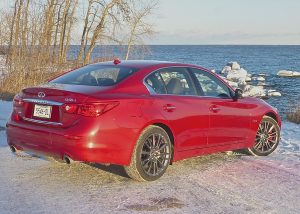
Infiniti makes larger sedans and SUVs, but the Q50 is the sportiest, and, arguably, the most attractive.
It’s hard to say whether consumers are aware of all that intermingling engine-building stuff, but Nissan’s reputation for making strong and sporty engines helped it make the largest gains in sales of any car-maker in 2016. As is the case throughout the industry, trucks led the way. Nissan sold 53,313 trucks in the U.S. in January of 2017, with the Rogue accounting for 28,760 of them, rising 46 percent. Pathfinder increased sales by 13 percent, the Quest minivan 32 percent, and the new full-size Titan pickup up by 195 percent in its reintroduction.
Nissan’s Infinity upscale brand improved SUV sales, too, and overall it increased sales by 36 percent in January 2017 compared to January 2016, with 11,558 sold. It was led by the new nQ50. One test-drive will convince you why.
Challenger GT adds AWD for winter muscle
Filed under: Equinox, Autos
By John Gilbert
PORTLAND, Maine — Driving a powerful muscle car on a curving icy roadway can become a sudden thrill when it breaks traction and starts skidding as if it intends to broadslide into the snowbank on the right shoulder.
“Oops!” just doesn’t quite cover it.
But the instincts gained while driving up and down the hills od Duluth, Minnesota, paid rich dividends. I didn’t yank the steering wheel into the direction of the skid, and I didn’t abruptly hit the brakes. Instead, I eased off the gas slightly while steering in an attitude that let the vehicle’s traction-control straighten us out and continue on our intended path as I eased back into the middle of our lane.
“Good job,” said my co-driver, who had good reason to be less poised than I was as we sailed through the woods just outside Portland, Maine. We were cheating, though, because the red Challenger we were in was a pre-production GT model with all-wheel drive.
It’s not as though we don’t get enough winter weather in Northern Minnesota, but there was no way to pass up this opportunity. Dodge invited a group of auto journalists to visit the rock-bound coast of Maine at the end of January for the first chance to drive the new Challenger GT, which, for 2017, can be bought with all-wheel drive. As such, I felt obligated to push it toward its limits.
The Challenger is a vehicle that is always fun to drive, joining the Ford Mustang and Chevrolet Camaro among the three “ponycar” throwbacks — I call them “future retro” — because they recreate the Trans-Am road-racing heyday of the late 1960s and early 1970s in North America. Dodge calls them “Muscle Coupes,” which is OK, too.
The three were ferocious rivals in road-racing, and among the joys of my sports and auto writing career was to be able to cover that Trans-Am series at places such as Donnybrooke Speedway (now BIR, for Brainerd International Raceway), Elkhart Lake, Bridgehampton and all points where road-racing circuits existed. They were a diversion from the hot-rod sedans of the late 1960s and the spider-like open-wheeled formula cars, with 2 doors and a specific silhouette of long-hood, short rear deck.
The Mustang continued on while the Camaro and Challenger were discontinued along with the Pontiac Trans-Am, Plymouth Barracuda, American Motors Javelin and a few others. But about the time Ford decided to redo the Mustang in a style that recaptured the attitude and demeanor of the 1970 model, Camaro came back out and did the same thing, and so did Challenger.
Dodge’s great-looking Challenger was created by dropping the coupe body on the platform for the larger Charger 4-door sedan, and the shortcut produced a very competitive vehicle. In some ways, it has an edge.
Some say the Challenger looks most like the 1970 car, but in any event it has a larger trunk and a more spacious interior, which can actually house a couple of adults in something approaching comfort. But in all cases, the Challenger, Mustang and Camaro are summertime cars, with front-engine, rear-drive that makes for enormous fun in the summer, spring and fall, but virtually need to be parked in the winter if you live in snowy weather. No traction control system can conquer the glare ice of winter with a rear-driver.
The Dodge Charger added a model a few years ago with an all-wheel-drive system underneath. While the arsenal of Hemi V8s make both the Charger and Challenger fly, the very strong 3.6-liter Pentastar V6 is more than capable in the Charger and Challenger, and works well enough in the AWD version of the Charger that many police departments deploy it to chase — and catch — the bad guys in bad weather.
We should have anticipated this move, then. Dodge has refined that all-wheel-drive system for the smaller Challenger coupe. “We were able to take the all-wheel-drive system from the Charger and use it in the Challenger,” said chief engineer Allison Rahm. “It’s not exactly the same, because we had to refine it in a few ways. We took the Charger Pursuit sedan, used by some police departments, and adapted the suspension, stabilizer bars, springs and steering calibration, and gave it its own vehicle dynamic control that uses the same front-axle disconnect.
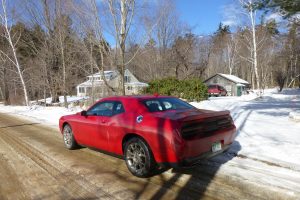
Instead of being skittish, and skiddish, the Challenger GT has newfound stability, even on icy rural roads of Maine..
“We have developed the perspective on a test area we use in Northern Michigan, where they have huge snow-pack fields. We learned we can push the car and stay in control, so it’s fun, cool, and you can drive it very confidently. It goes back to rear-wheel drive when you don’t need it, but in snowy conditions, or when it senses wheelspin, its sensors can send up to 100 percent of the torque to the front.”
How the car is being driven also activates AWD, and the unit only adds 200 pounds to the overall weight of the Challenger, which sits low and doesn’t betray the fact that all four wheels can pull the car.
Ben Lyon showed us an interesting map of the U.S. with a horizontal line across the middle, from northern California to the East Coast. Market research indicates all-wheel-drive models of the Charger and such SUVs as the Durango are up 12 percent year-over-year in sales from last year. On the Charger, AWD makes up 17 percent of purchases altogether, and in the 17 states north of that horizontal line across the nation, the take rate is over 50 percent all-wheel drive on vehicle purchases.
“We also surveyed buyers who looked at the Challenger but didn’t buy,” said Lyon, the Challenger brand manager. “One-third said all-wheel drive was important, and when they stopped considering the Challenger, half of them then bought something with all-wheel drive.”
We had our choice of colors and I took red, instead of orange. Both were stunning. Powering the Challenger is that Pentastar V6, a 3.6-liter unit with 305 horsepower at 6,350 RPMs, and 268 foot-pounds of torque at 4,800 RPMs. More than 90 percent of the peak torque is provided from 1,800 to 6,400 revs which gives you pretty constant power anywhere in the tach’s range.
The only thing that rivals that power is the audio system, which barks through a 506-watt amplifier. A surprisingly large trunk and fold-down rear seat allow you to haul long things, even skis. Specific GT leather bucket seats and trim on the dash and console set the car apart as well.
Naturally, all the goodies boost the price. Our test car started at $33,395 and as-tested it was $40,555.
Stability control and all the assumed connectivity features of Apple CarPlay and Android Auto can be brought to life. Also, the performance information from the Hellcat Trac Pak with readouts on the 8.4-inch center screen let you monitor 0-60 times, G-forces and a launch-control device.
For driving performance, the power is harnessed by the 8-speed automatic with paddle shifters, and if you switch into Sport mode, or drive aggressively, you are immediately in all-wheel drive. Otherwise, your driving style will summon AWD instantly and seamlessly by assessing road conditions.
We found driving the Challenger GT smooth and precise, with the possible exception of my little unscheduled side-skid that threatened the shoulder. So we were ready for the test track, even as the temperature climbed to a less-than-challenging 45 degrees. We would have prefered the harshness of the “Nor’easter” that hit the area one day earlier.
I had the chance to be first out on the well-groomed test track at a road-racing course Dodge had contracted, with a circular stability track, a straight line acceleration stretch, and a small autocross-like circuit that could challenge us for our driving response and the car’s capability.
The stylish 19-inch wheels were shod with some high-performance all-season Michelin tires, and they proved pretty good — but not exceptional to a winter-driving veteran. Michelin might be the best at building tires for long wear and high speed, but to do that, the tread compound is firm enough that it becomes hard — and slick — in severe cold. Such as winter.
The production Michelins worked well to test the car around the circular skid course, where you could jockey the car back and forth and even provoke a bit of skidding, just for fun. After several laps around that, in 6-inch deep snow, we moved over to the auto-cross like course.
The groomer had done a great job smoothing out the trail, and my instructor informed me that I could be confident staying on the power if we got off into the deeper snow. I got off a little, putting the left-side tires into the fringe area, and when I stayed on the power, it went a bit farther off, until it got hung up.
I know enough to stay on the power in moderate snow, and I did that, right until it hung itself up, What fooled us was that the groomer had groomed a bit wider than the outer groove, so when I thought I was still on the track, the left side tires already were off the surface. No problem. Four guys tried to push me out, but we had to summon the groomer, which hooked up to the rear and pulled us out of the snow.
That may have helped set the stage for the rest of . I suggested to Ms. Rahm, the chief engineer, that the Michelins were probably excellent for 90 percent of the all-weather driving Dodge might anticipate for the car’s use, but I would suggest a set of Nokian all-season or snow tires.
I’m guessing that won’t happen, because no automaker builds a car with tires aimed specifically at snow-country. And that’s OK. All-wheel drive already gives the Challenger GT AWD a large jump on Mustangs and Camaros — and virtually all other muscle cars — on snow and ice. With the right winter tires, it could could make hardy drivers park their SUVs.


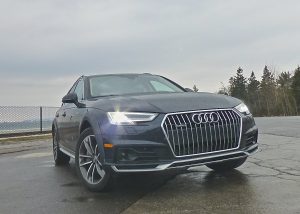
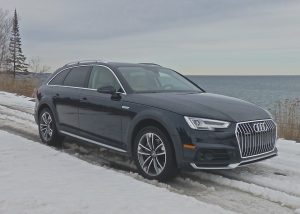
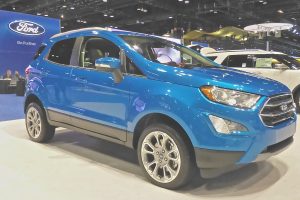
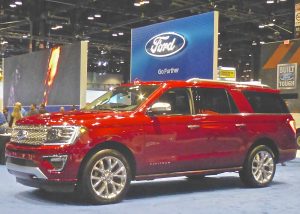

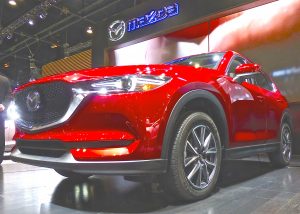
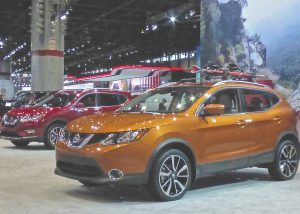

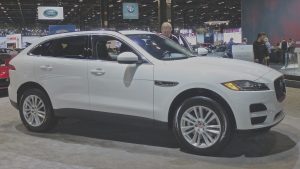
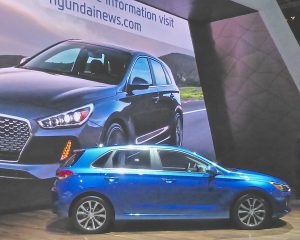
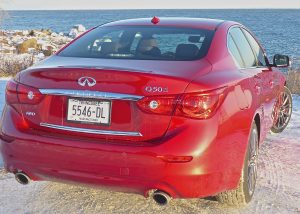
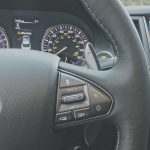
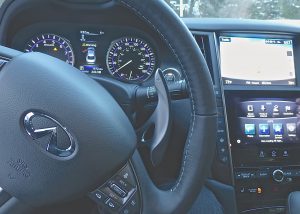
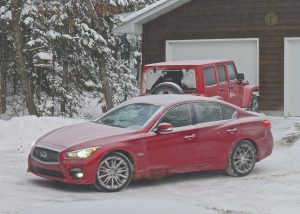

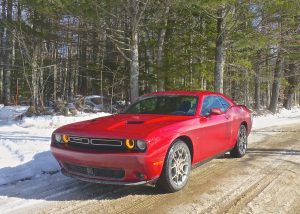
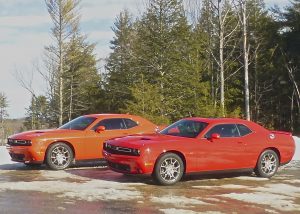
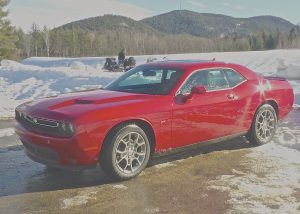
 John Gilbert is a lifetime Minnesotan and career journalist, specializing in cars and sports during and since spending 30 years at the Minneapolis Tribune, now the Star Tribune. More recently, he has continued translating the high-tech world of autos and sharing his passionate insights as a freelance writer/photographer/broadcaster. A member of the prestigious North American Car and Truck of the Year jury since 1993. John can be heard Monday-Friday from 9-11am on 610 KDAL(www.kdal610.com) on the "John Gilbert Show," and writes a column in the Duluth Reader.
John Gilbert is a lifetime Minnesotan and career journalist, specializing in cars and sports during and since spending 30 years at the Minneapolis Tribune, now the Star Tribune. More recently, he has continued translating the high-tech world of autos and sharing his passionate insights as a freelance writer/photographer/broadcaster. A member of the prestigious North American Car and Truck of the Year jury since 1993. John can be heard Monday-Friday from 9-11am on 610 KDAL(www.kdal610.com) on the "John Gilbert Show," and writes a column in the Duluth Reader.